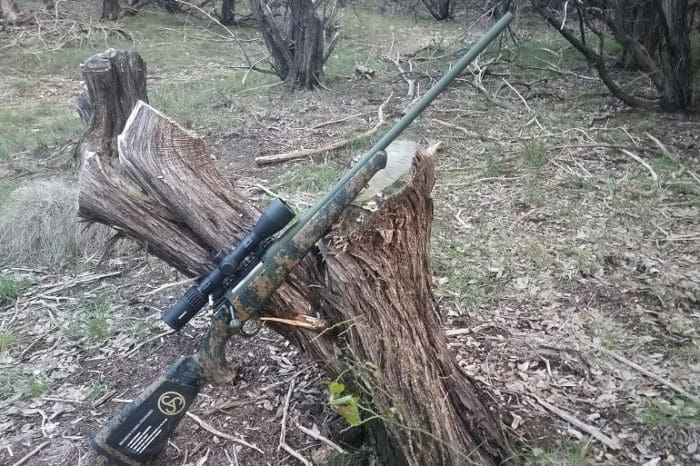There are actually a lot of things to consider before buying a bolt-action rifle, but we’re going to hit on a few of the big points so this post doesn’t become novel-length. This is directed more for the beginner than the advanced rifle shooter.
What’s the primary use?
Consider what you’re getting the rifle for. Guns are many things, but they are in many instances a tool, and you should consider the task that you are getting it for. You can use a flathead screwdriver as a chisel in a pinch, but you should really use a chisel when you need one.
Are you buying the rifle for target shooting?
Once you know that, you should be able to start identifying the features that are best-suited to the application as well as caliber.
For just plain ol’ plinking at moderate ranges, a bolt gun in .22 LR or even up to .223 Remington works well. It’s cheap, clean fun, and you can do some small-game hunting, varmint shooting or even cull some coyotes.
If serious target shooting and at long range is more your fare, then perhaps a chassis-based rifle in 6.5mm Creedmoor, or one of the serious long-range magnums (.300 Win Mag, .338 Lapua, etc.) and a rail for easy mounting of a big tactical scope.
If meat in the freezer is more your intended task, then a classic bolt rifle in an appropriate caliber for the game you intend to pursue and at the ranges you intend to pursue it at. You probably don’t need a .30-06 for beanfield hunting in the East.
Out here in the West we need a cartridge with more legs than .300 Blackout or .30-30 for elk, bears, and big-bodied mulie bucks, and shot opportunities might only come at 400 yards…or beyond.
Granted, we can also get into the past 400 debate, but that’s a topic for another time.
Also, a classic bolt-action for hunting is perfectly capable of benchrest shooting, so you can have the best of both worlds. The sport’s existence owes much to Warren Page, who did a lot of bench shooting (and a lot in the field; he harvested more than 400 head of game on multiple continents) in an era when chassis-based rifles basically didn’t exist. So that Winchester, Remington, Savage, Howa or what have you can actually do it all.
Can you find the gun you want used?
First — and this might not seem as obvious as one might think — can you get the same gun used?
That might seem ludicrous, but give me some rope here.
Bolt-action rifles are usually very durable. Few people will ever “shoot the barrel out” and plenty of folks consign perfectly good rifles to the used rack despite nothing being wrong with the gun.
Sometimes it’s for a good reason, sometimes it’s because it turns out they’d rather shoot a less-powerful caliber that won’t bruise their shoulder. Sometimes it’s because they just want to get a newer gun, or don’t have a use for it any more.
There’s a Cabelas about a mile away from my office. Their Gun Library and used gun racks are always festooned with late-model bolt-action rifles (some scoped, some not) that clearly haven’t been used much.
Usually the chambering is either 7mm Remington Magnum or .300 Winchester Magnum, which would seem to indicate that a lot of people buy too much gun for themselves and then go down in caliber to something like .270 Winchester or 6.5mm Creedmoor.
There was a pre-64 Model 70 at Cabelas when I was there recently, and it took a lot of resolve not to put it on layaway. I might have regretted it if I had, which is what I’m going to try and tell myself a few dozen more times over the next few weeks.
The point? If you’re buying a bolt-action rifle for a specific purpose, there’s a chance you can get the bolt-action rifle you want, gently used, for a good deal less cash if you buy used. And you probably won’t have to worry about break-in.
Lastly . . .
Optics?
If you’re going to use optics, make sure you do just as much research on picking a good scope for your rifle. Perhaps a 3-9x40mm is perfect for you; perhaps a 2-7x is better, or, for that matter, maybe a 6-24x for long-range target shooting is better suited for your purposes.
The conventional wisdom is to spend as much on the scope as you do on the rifle, if not more. The glass, arguably, matters more.
Back when our grandfathers (or even great-grandfathers) were buying their rifles, you had to spend a bit to get a truly accurate rifle. Or get lucky. Even the vaunted pre-’64 Winchester Model 70 rifles didn’t shoot MOA groups. A few people got one that did, but it was mostly the luck of the draw.
This is the good ‘ol days of guns. There are plenty of budget-friendly bolt action rifles that will shoot MOA groups and can be had for not a whole lot of money. Unless there’s a specific caliber you need or want, or a specific feature (like a chassis stock or a railed receiver) you can actually get all the rifle you need for not a whole lot of cash.
Make sure, then, that you’re getting good glass to mount on yours.
So consider what kind of scope you need and find the best example of the kind that you can responsibly afford. A quality scope on a budget rifle will give you better results than a budget scope on a high quality rifle.
There are, of course, many more factors to consider when buying a bolt-action rifle. What are some other considerations to bear in mind before pulling the trigger, so to speak, that you can think of? Sound off in the comments.
